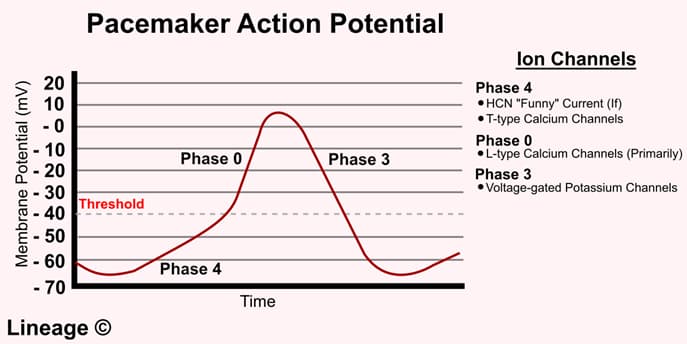Overview

SA Node Action Potential; also AV Node
- Phase 0, upstroke
- action potential opens L-type voltage-gated Ca2+ channels
- secondary to T-type voltage-gated Ca2+ channels further depolarizing cell membrane enough to reach threshold for L-type votage-gated Ca2+ activation → upstroke
- slope of upstroke is slower than other cardiac myocytes
- due to lack of large Na+ currents in SA and AV nodal cells
- due to non-rapid Ca2+ movement via channels
- action potential opens L-type voltage-gated Ca2+ channels
- Phase 1 and 2 are absent in SA node action potential
- Phase 3: repolarization
- voltage-gated K+ channels open → ↑ K+ conductance → outward K+ current → repolarization
- Phase 4: diastolic depolarization
- accounts for automaticity of SA node cells
- to generate an action potential spontaneously without neural input
- hyperpolarization-activated cyclic nucleotide-gated (HCN) channel generates “funny” current (If)
- repolarization activates HCN channels
- non-selective monovalent ion channel
- evokes Na+ mediated depolarization
- If slow depolarization activates T-type voltage-gated calcium channels
- reduced outward K+ current contributes to depolarization
- accounts for automaticity of SA node cells
- Heart rate
- set by the rate of depolarization in phase 4
- ↑ rate of phase 4 depolarization → reach threshold faster → ↑ action potential per unit time by SA node cells → ↑ heart rate
- pharmacology correlate
- sympathetic nerveous system stimulation → ↑ heart rate
- norepinephrine acts on β1 receptors in SA node → ↑ If → ↑ rate of phase 4 depolarization → ↑ heart rate
- example of a positive chronotropic effect
- norepinephrine acts on β1 receptors in SA node → ↑ If → ↑ rate of phase 4 depolarization → ↑ heart rate
- parasympathetic nervous system stimulation → ↓ heart rate
- acetylcholine acts on M2 receptors in SA node → ↓ If → ↓ rate of phase 4 depolarization → ↓ heart rate
- also ↑ K+ conductance → ↑ outflow K+ current via K+-ACh receptors
- an example of a negative chronotropic effect
- acetylcholine acts on M2 receptors in SA node → ↓ If → ↓ rate of phase 4 depolarization → ↓ heart rate
- sympathetic nerveous system stimulation → ↑ heart rate
- set by the rate of depolarization in phase 4


